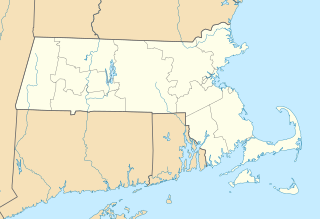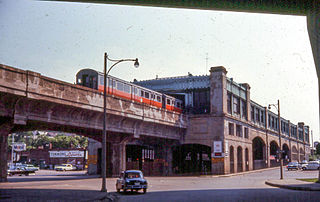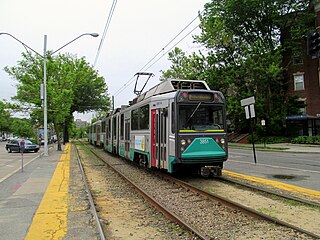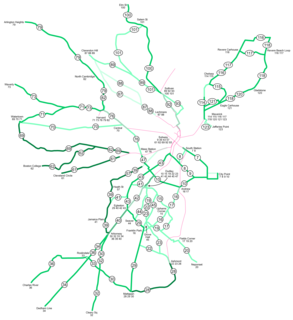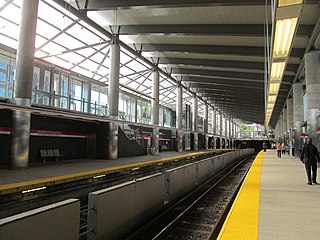 | |
 Orange Line train near Ruggles station | |
| Overview | |
|---|---|
| Owner | Massachusetts Bay Transportation Authority |
| Locale | Boston, MA |
| Transit type | rapid transit: heavy rail, light rail, and bus rapid transit |
| Number of lines | 3 heavy rail (Red Line, Orange Line, Blue Line), 2 light rail (Green Line, Ashmont–Mattapan High Speed Line), 1 BRT (Silver Line) |
| Number of stations | 133; [1] 6 new stations are being built as part of the Green Line Extension (GLX) project [2] [ dubious ] |
| Annual ridership | 352,519,591 (2014) [1] [note 1] |
| Website | mbta |
| Operation | |
| Began operation | September 1, 1897 (Tremont Street Subway) |
| Operator(s) | Massachusetts Bay Transportation Authority (MBTA) |
| Train length | 6 cars (heavy rail) 1-3 cars (light rail) |
| Technical | |
| System length | 78 mi (126 km) |
The Massachusetts Bay Transportation Authority (MBTA) operates heavy rail, light rail, and bus transit services in the Boston metropolitan area collectively referred to as the Rapid Transit, Subway or T system. [1]
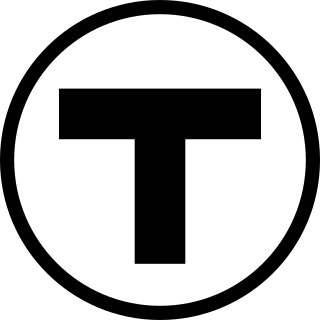
The Massachusetts Bay Transportation Authority is the public agency responsible for operating most public transportation services in Greater Boston, Massachusetts. Earlier modes of public transportation in Boston were independently owned and operated; many were first folded into a single agency with the formation of the Metropolitan Transit Authority (MTA) in 1947. The MTA was replaced in 1964 with the present-day MBTA, which was established as an individual department within the Commonwealth of Massachusetts before becoming a division of the Massachusetts Department of Transportation (MassDOT) in 2009.

Light rail, light rail transit (LRT), or fast tram is a form of urban rail transit using rolling stock similar to a tramway, but operating at a higher capacity, and often on an exclusive right-of-way.

Bus rapid transit (BRT), also called a busway or transitway, is a bus-based public transport system designed to improve capacity and reliability relative to a conventional bus system. Typically, a BRT system includes roadways that are dedicated to buses, and gives priority to buses at intersections where buses may interact with other traffic; alongside design features to reduce delays caused by passengers boarding or leaving buses, or purchasing fares. BRT aims to combine the capacity and speed of a metro with the flexibility, lower cost and simplicity of a bus system.
Contents
The colored rail trunk lines consist of 3 heavy rail lines (Red, Orange, and Blue), one branched light rail system (Green), and a short light rail line (the Ashmont-Mattapan High Speed Line, colored as part of the Red Line). All except the Ashmont-Mattapan Line operate in tunnels in the downtown area, but no route operates entirely underground. Only 26 out of the system's 133 stations are located underground. The five branches of the Silver Line bus are also shown as part of the rapid transit system. Three branches operate underground as bus rapid transit and charge rapid transit fares; two branches operate entirely on the surface and charge lower bus fares.

The Red Line is a rapid transit line operated by the Massachusetts Bay Transportation Authority (MBTA). It runs roughly northwest-to-southeast across Cambridge and Davis Square in Somerville – from Alewife in North Cambridge to Kendall/MIT in Kendall Square – with a connection to commuter rail at Porter. It then crosses over the Longfellow Bridge into downtown Boston, where it connects with the Green Line at Park Street, the Orange Line at Downtown Crossing, the Silver Line at South Station, as well as Amtrak and commuter rail at the South Station surface terminal before passing through South Boston and Dorchester. South of JFK/UMass in Dorchester, it splits into two branches terminating at Braintree and Ashmont stations; transfers to commuter rail are again possible at JFK/UMass, Quincy Center, and Braintree. From Ashmont, passengers may continue to Mattapan via the Ashmont–Mattapan High Speed Line, a 2.6-mile (4.2 km) light rail line.

The Orange Line is one of the four subway lines of the Massachusetts Bay Transportation Authority. It extends from Forest Hills in Jamaica Plain, Boston in the south to Oak Grove in Malden in the north. It meets the Red Line at Downtown Crossing, the Blue Line at State, and the Green Line at Haymarket and North Station. It connects with Amtrak service at Back Bay and North Station, and with MBTA Commuter Rail service at Back Bay, North Station, Forest Hills, Ruggles station in Roxbury, and Malden Center in Malden. From 1901 to 1987, it provided the first elevated rapid transit in Boston; the last elevated section was torn down in 1987 when the southern portion of the line was moved to the Southwest Corridor.

The Blue Line is a rapid transit line in the Greater Boston metropolitan area, one of four rapid transit lines operated by the Massachusetts Bay Transportation Authority (MBTA). It runs from Bowdoin station in downtown Boston under Boston Harbor to East Boston and Revere on the inner North Shore, where it terminates at Wonderland. The stop at Airport Station, by way of a free shuttle bus, is one of two rapid transit connections to Logan International Airport. In 1967, during a systemwide rebranding, the line was assigned the blue color because it passes under the Boston Harbor. With an end-to-end travel time of less than twenty minutes, the Blue Line is the shortest of Boston's heavy-rail lines and the only line to have both third rail and overhead catenary sections.
The section of the Tremont Street Subway between Park Street and Boylston Street stations on the Green Line opened in 1897, making it the oldest transit subway in the United States still in use. (Only the short-lived Beach Pneumatic Transit demonstration line in New York City was built before.)

The Beach Pneumatic Transit was the first attempt to build an underground public transit system in New York City. It was developed by Alfred Ely Beach in 1869 as a demonstration subway line running on pneumatic power. As the subway line had one stop and a one-car shuttle going back and forth, it was not a regular mode of transportation. It lasted from 1870 until 1873.







